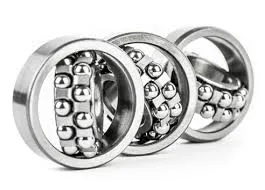
Dec . 24, 2024 18:02 Back to list
Understanding the Functionality and Applications of Cylindrical Roller Bearings in Machinery
Cylindrical Roller Bearings Design, Types, and Applications
Cylindrical roller bearings are a crucial component in many mechanical applications, known for their ability to handle heavy radial loads with minimal friction. These bearings are designed with cylindrical rolling elements that provide a greater contact area with the raceway, allowing for efficient load distribution and reduced wear. This unique design sets cylindrical roller bearings apart from other types of bearings, making them highly desirable in various industries.
Design and Variants
The fundamental design of cylindrical roller bearings consists of an outer ring, an inner ring, and rolling elements arranged between them. The cylindrical rollers provide a high load-carrying capacity and can accommodate both radial and some axial loads. They are typically available in several configurations, including
1. Single Row Cylindrical Roller Bearings This is the most common design, featuring a single row of rollers. They provide high radial load capacity and are suitable for various applications, including electric motors and machine tools.
2. Double Row Cylindrical Roller Bearings By having two rows of rollers, these bearings can handle greater radial loads and provide additional stability. They are often used in heavy machinery and industrial equipment.
3. Multi-Row Cylindrical Roller Bearings These complex designs enable even higher load capacities and are usually tailored for specific applications, such as in railway axles or large rotating machinery.
4. Caged vs. Full Complement Caged cylindrical roller bearings contain a cage that separates the rollers, allowing for better lubrication and reduced friction. Full complement designs, which have no cage and contain the maximum number of rollers, offer higher load capacities but may have increased friction.
Advantages of Cylindrical Roller Bearings
Cylindrical roller bearings possess several advantages that make them suitable for a diverse range of applications
- High Load Capacity Thanks to their design, they can carry substantial radial loads, making them ideal for heavy industrial machinery.
cyl roller bearing

- Low Friction The cylindrical shape of the rollers minimizes friction, resulting in higher efficiency and lower operational costs.
- Durability Made from high-quality materials, these bearings are designed for longevity, capable of withstanding harsh environmental conditions
.- Versatility Their various designs allow them to be used in a wide array of applications, from automotive and aerospace industries to manufacturing and construction.
Applications
The unique characteristics of cylindrical roller bearings make them an integral part of many industries. Some notable applications include
- Automotive Industry Used in gearboxes, wheel hubs, and electric motors, these bearings support significant loads and contribute to vehicle performance.
- Industrial Machinery Common in conveyor systems, pumps, and compressors, cylindrical roller bearings help maintain operational efficiency in manufacturing and production processes.
- Railway Applications Their robust load capacity makes them essential in railway axle applications, where they endure dynamic loads and require high reliability.
- Aerospace In the aerospace sector, these bearings are crucial in aircraft engines and landing gear systems, where safety and performance are paramount.
Conclusion
Cylindrical roller bearings are essential components in modern engineering and machinery, offering high load capacities, low friction, and versatile application potential. Their design innovations have significantly enhanced their performance in various industries, making them a reliable choice for engineers and manufacturers alike. As technology continues to advance, the demand for efficient and robust bearing solutions, such as cylindrical roller bearings, is likely to grow, reinforcing their importance in future developments.
Latest news
-
Durable Greenhouse Pillow Block Bearings for Reliable Ventilation
NewsAug.31,2025
-
Spherical Roller Bearings Applications: Heavy Duty, Self-Aligning
NewsAug.30,2025
-
Premium Deep Groove Ball Bearings | High Speed & Reliability
NewsAug.29,2025
-
Durable Scaffolding Clamps - Secure & Reliable Tube Connectors
NewsAug.28,2025
-
Common Failures in Thrust Ball Bearings and Solutions
NewsAug.22,2025
-
How Tapered Roller Bearings Can Take Shock Loads
NewsAug.22,2025
